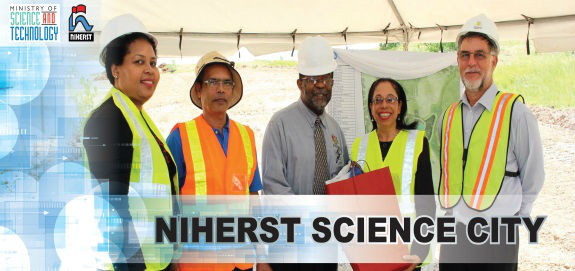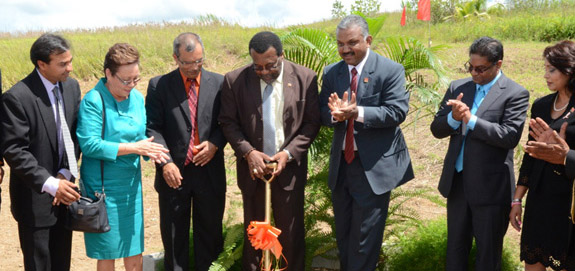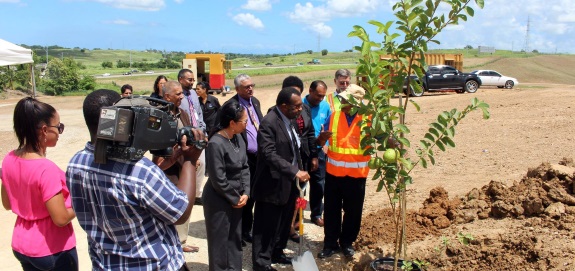NIHERST Science City TVC
(Fab Lab & Crop Maze)
August 28th, 2015
Government to build Science City
Richard Lord
The Guardian Newspaper
Science and Technology Minister Dr Rupert Griffith says a permanent home for showcasing local innovation will be established in T&T. Griffith was addressing the Prime Minister’s Awards for Scientific Ingenuity 2015 at Hyatt Regency, Port-of-Spain, on Monday night. Griffith said the Science City would be similar to the Smithsonian Institution in the United States. The minister said the project was being undertaken by Niherst and would be located close to the recently opened Children’s Hospital in Couva.
He said it was envisioned to be “a high-tech hub with advanced state-of-the-art R&D (research and development) facilities for product development and commercialisation and a centre for technology.” He said Arquitonicia GEO was partnering with Niherst in the venture as design consultant, landscape architect and design architect. Griffith said his ministry had engaged in the right partnerships to facilitate the adoption of new technology through technology transfer. He said a key component of that was T&T’s involvement in a European Union-Community of Latin America and the Caribbean (EU-CELAC) Bilateral Arrangement.
He said T&T was also coordinating inter-ministerial collaboration in policy development, planning and implementation. The winner in the junior category in the Scientific Creative Solutions Competition was Shamiya Charles with her entries titled The Ultimate Fruit and Vegetable Vendor Stand and The Ultimate Portion Controller. The winner in the senior category of the Scientific Creative Solutions Competition was Dr Natasha Ramroop Singh with her entry Novel Biosensor for Thyroid Disorders.
The winner of the Scientific Innovation and Invention Award was Dr Eesa Wahid with his presentation Constant Voltage High Rate Lithium Battery. That innovation was “a battery with specialised circuitry that has been adapted to a lithium battery to create a power supply that does not experience voltage drops typical of car batteries.”
The competition was aimed at “stroking the innovative spirit and capacity of our people to advance government’s goal of a highly-diversified, sustainable and globally-competitive economy,” Niherst said.
Science City 2015
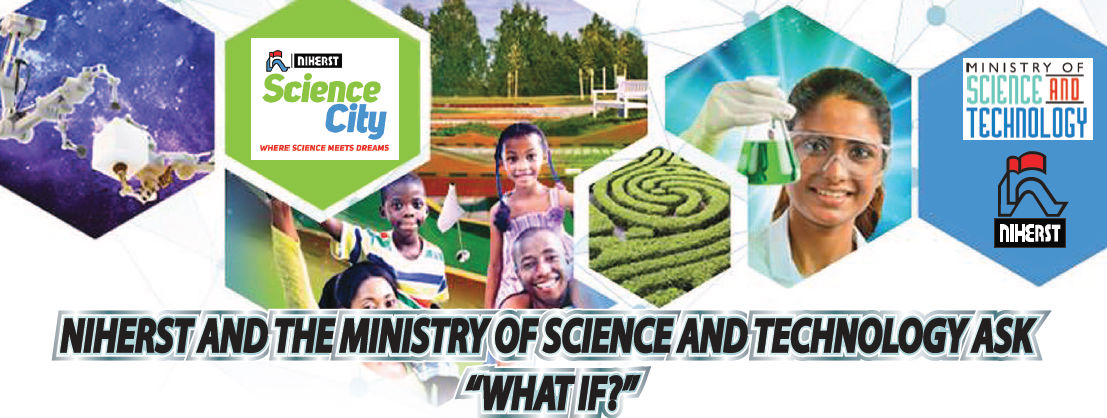
NIHERST and the Ministry of Science and Technology are asking the nation, “What If? What if you could take your children to a land of imagination and learning? What if you could do research in a world-class scientific environment, or experience space in a completely new way?” All this and more will be possible at NIHERST Science City, currently under construction.
At a recent on-site consultation with residents of the area, Professor Prakash Persad, Chairman of NIHERST, shared the plans and tremendous possibilities for NIHERST Science City. Science City will serve as a national and international case study on a visitor learning environment merged with high-tech research facilities, all aimed at promoting innovation and entrepreneurship. This learning landscape and its green buildings will be a restoration of the 54 acres of abandoned sugar cane fields on which Science City is being constructed, healing the degraded land, and inspiring the nation and the rest of the Caribbean through experiential learning of science and technology. A central lake will be formed through a series of dams.
Science City is integral to NIHERST fulfilling its mission to spur research and innovation, shape policy and improve STEM education for Trinidad and Tobago’s advancement. Its state-of-the-art R&D facilities for product development and commercialisation, and a centre for technology adoption and adaptation. It will support government’s economic diversification effort, linking science commercialisation with science popularisation, and thereby fostering a culture of technopreneurship within the national community. The Science City facilities will thus provide the mechanism for exploiting the native genius of the population, through S&T, for national development. At the 2015 Caribbean Youth Science Forum, hosted by NIHERST in early August, Dr. the Honourable Rupert Griffith, Minister of Science and Technology, stoked the interest and imagination of the young science students participating when he stated that ,”Once completed, the space will bring not only economic benefits to the region, but it will also attract and retain the best scientific talent, and the research and development undertaken at Science City will spawn start-up companies and spin offs.”
NIHERST, with its partner, ArquitectonicaGEO - the main design consultant, landscape architect and design architect for Science City - recently received an Award of Honour for the Science City concept at the 2015 Florida ASLA Conference & Expo in July 2015. This award, falling under the Planning and Analysis category, is bestowed in recognition of projects that “demonstrate the inspired use of landscape architectural practices in an imaginative and well-resolved combination that adds to the body of the Landscape Architecture profession.”
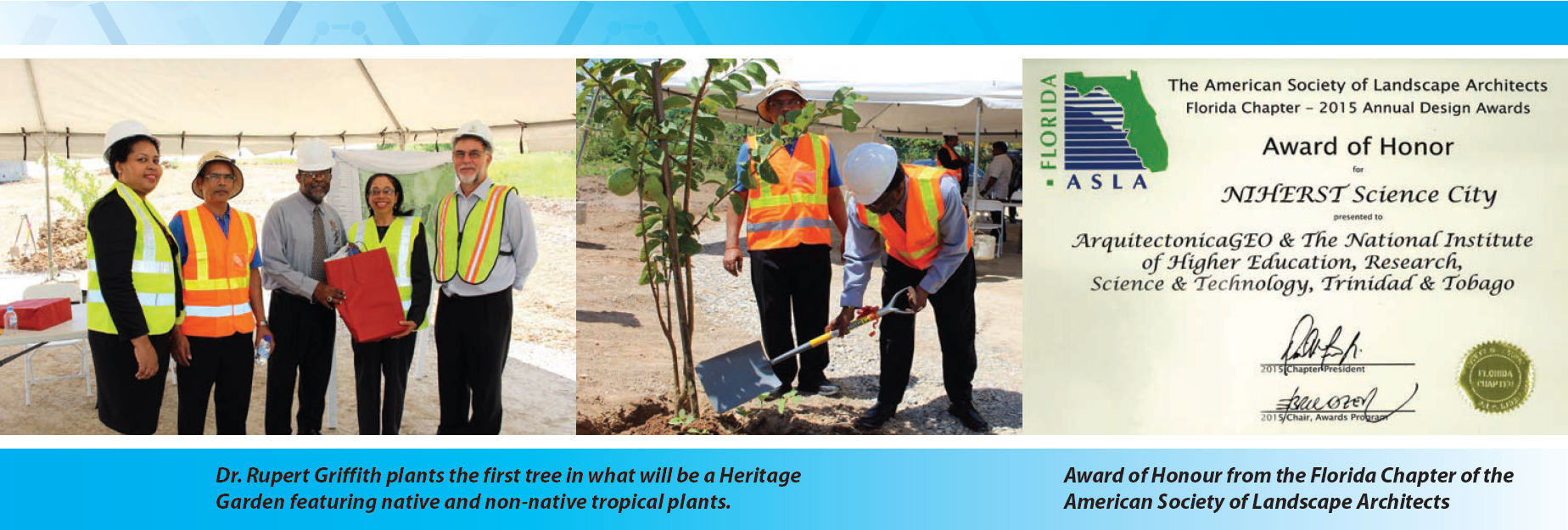
Planetarium
coming to NIHERST Science City
August 19th, 2015
Silver economy spurred on by robotics
By Prakash Persad
The Trinidad Guardian Newspaper
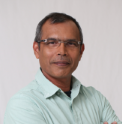 It is estimated that globally there are over 470 million people 65 years and over. That is a little less than seven per cent of the population of the world. The actual percentage for the developed world is quite higher. Further, this cohort is estimated to grow to some 820 million by
2025.
It is estimated that globally there are over 470 million people 65 years and over. That is a little less than seven per cent of the population of the world. The actual percentage for the developed world is quite higher. Further, this cohort is estimated to grow to some 820 million by
2025.
The "silver economy" has thus been a reality in many countries and the pace of development of technology to assist the elderly is increasing, particularly in Japan, USA and Western Europe. T&T's elderly population is above 10 per cent and is also expanding and thus it is timely that attention is being paid to it.
As humans grow older, both strength and mobility are impacted. To ensure that the quality of life of the elderly is not unduly compromised, assistive technologies have been developed. These include single-person staircase escalators and electric wheel chairs for mobility and ICT devices to allow for easy communication with loved ones and caregivers.
Robotics is being seen as an area with tremendous growth potential and accordingly effort is being expended in that direction. It is giving rise to new and innovation technologies and will, in all probability, become a significant component of many economies, more so as Internet connectivity and capacity improve and increase.
Individual and institutional care givers have, on a daily basis, to pick up patients. This act is quite stressful on the back and thus exoskeleton robotic like devices would be a boon to them. Such devices already exist is industry for loading cargo and equipment Lightweight ergonomically designed exoskeletons would find a ready market, not only in nursing homes, but also among the independent-minded elderly.
Sitting up and getting of the bed are also activities that many old and or sick people find quite difficult. This is being addressed by the development of innovative technologies. Beds are being developed that can both raise the person to a sitting position and double up as a wheel chair. This technology would completely remove the need to stand up to be transferred, which is when falls are likely happen.
Another promising development is that of telepresence robots. In fact, last month, President Obama welcomed one into the White House. In Sweden, clinical trials of such devices are being conducted as they can offer an efficient and cost effective mechanism for home-based caregiving. This is possible as patients can be seen and spoken to from remote locations (hospitals, clinics and doctors' offices in layman language.)
When this technology is combined with automated home health systems in which sensors monitor and record health parameters like blood pressure and body temperature, then effective diagnoses and advice can be dispensed without the doctor having to be physically present in front of the patient as he/she would have the necessary information to make an informed decision.
One other important attribute of telepresence robots is that they can detect if one is still for a long time and will thus make the necessary alerts.
The silver economy presents T&T with an excellent opportunity to develop and adapt assistive technologies for use here and worldwide. This requires multidisciplinary design teams and high-end design and fabrication facilities. This kind of enterprise is exactly what is envisaged by NIHERST Science City, where doctors, engineers and technologists can design, fabricate and do clinical studies on new and innovative assistive technologies or adapt and induct emerging technologies for use in hospitals and nursing homes.
Within the framework of a national S&T policy that harmonises the R&D effort of the health institutions, the universities and other interested parties, robotics technology-based technology enterprises can develop into an important element of the diversification effort.
NIHERST Science City
clip from NIHERST’s 30th Anniversary video
August 14th, 2015
Rope Challenge & Wind Tunnel - Science City TV Clip
Feburary 9th, 2017
Robotics & Community Garden - Science City TV Clip
Feburary 9th, 2017
Fab Lab & Crop Maze – Science City TV Clip
August 28th 2015
Hydro Solar & Wind Power – Science City TV Clip
Feburary 9th, 2017
Planetarium – Science City TV Clip
August 19th 2015
NIHERST Science City Ad
August 13th, 2015
ROBOTIC LAGAHOOS AND FOLKLORE TRANSFORMERS
By Prakash Persad
The Trinidad Guardian Newspaper
 Transformers or shape shifting robots have been established in science fiction. They have proven to be so popular that there is a movie series on the topic and at least one animation television series. The transformer enterprise includes toys and other paraphernalia associated with the movie industry. In other words, a financially profitable enterprise. But right here in Trinidad and Tobago, shape shifters have been central to our folklore, which we have not really exploited. These shape shifters include the Lagahoo, La Diablesse etc.
Transformers or shape shifting robots have been established in science fiction. They have proven to be so popular that there is a movie series on the topic and at least one animation television series. The transformer enterprise includes toys and other paraphernalia associated with the movie industry. In other words, a financially profitable enterprise. But right here in Trinidad and Tobago, shape shifters have been central to our folklore, which we have not really exploited. These shape shifters include the Lagahoo, La Diablesse etc.
The NIHERST Science City will change this by including an outdoor robotic park that will feature robotic lagahoos and other folklore creatures. Yes, high technology will converge with traditional folklore to provide an attraction that will not only entertain but will also have strong elements of discovery and learning.
Shape shifting robots have been demonstrated since 2008. In 2012, MIT researchers created a robotic device that can take on almost any shape imaginable. In 2015, scientists at China’s Tsinghua University discovered a liquid alloy that shape shifts. Shape shifting robots are set to take off.
Shape shifting has always been in the psyche of mankind from time immemorial and the folklore of most, if not all, cultures have shape shifters. A lagahoo (Ligahoo or the French loup garou) are shape shifters like the Germanic werewolf. This fascination with shape shifting is naturally exploited by film makers. The popularity of vampire and werewolf movies is a testament to this. The modern day robotic transformers represent a natural metamorphosis of the ancient realm of jumbees and mythical beings to the futuristic world of science fiction.
The NIHERST Science City presents a golden opportunity to nurture and develop the innovative and entrepreneurial talent of the country by merging West Indian culture with technology. The design of shape shifters or transformers like lagahoos and its ilk, requires significant multidisciplinary expertise. These include mechatronics, AI (artificial intelligence), materials and folklore.
The intent is to develop these robots using home grown and local expertise from academia and carnival exponents. To do this would require the adaptation of existing and emerging technologies as well as developing new ones. The R&D effort required to design, fabricate, operate and maintain such devices will result in high tech clusters which can form the basis for several spinoff enterprises. Further, as robots will be an integral part of the future, we will need robotic engineers amongst us.
Science and Discovery Centres, in both the USA and India, have expressed a keen interest in this outdoor robotic park as it is quite novel. It is expected that joint ventures in design and manufacture of such and similar devices will be the genesis of a home grown high tech industry.
Students at the local universities have always and do continue to complain that examples, particularly in engineering and technology, are foreign based. The involvement of locals in this nascent R&D based enterprise will have a strong win-win effect, resulting in an upward technopreneurial spiral. NIHERST has a culture of working harmoniously with the academic and other institutions in the country. This is a rarity in a country infamous for its inter- and intra-institutional silos and the resulting wasteful duplication. The aim is therefore to develop inter-institutional clusters which can really impact positively on the diversification effort while uplifting of the technological and technopreneurial expertise of the nation.
The economic benefits of the outdoor robotic park will be further enhanced by this progression of science popularization to science commercialization. The average citizen may not immediately grasp the tremendous benefits, in terms of jobs and revenue that science and technology bring, as the investment requires a fairly long term investment. This must change so that investment in science and technology is also seen as an economic necessity.
NIHERST Science City Project receives Award of Honour
from the Florida Chapter of the American Society of Landscape Architects
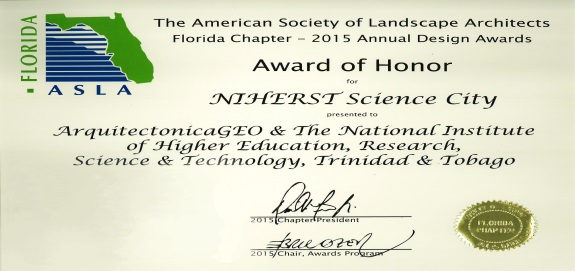
NIHERST, with its partner, ArquitectonicaGEO - the main design consultant, landscape architect and design architect for NIHERST’s Science City - recently received an Award of Honour for the Science City concept at the 2015 Florida ASLA Conference & Expo in July 2015.
This award, falling under the Planning and Analysis category, is bestowed in recognition of projects that “demonstrate the inspired use of landscape architectural practices in an imaginative and well-resolved combination that adds to the body of the Landscape Architecture profession.”
NIHERST’s Board of Governors and staff, led by Professor Prakash Persad, and ArquitectonicaGEO, in collaboration with leading national scientists, are working with a multidisciplinary team which includes Architects of Record, acla:works; Civil, Structural and MEP Engineers - CEP Ltd and Ramp Engineering Services Ltd.; Quantity Surveyors, BCQS; and Exhibit Designers, Thinc.
This learning landscape and its green buildings will be a restoration of the 54 acres of abandoned sugar cane fields on which Science City is being constructed, healing the degraded land, and inspiring the nation and the rest of the Caribbean through experiential learning of science and technology. A central lake will be formed through a series of dams. Extensive planning and analysis includes hydrology and plant restoration studies, and ongoing monitoring will be conducted by in-country experts.
NIHERST Science City is envisioned as a high-tech hub, with advanced state-of-the-art R&D facilities for product development and commercialisation and a centre for technology p. This learning landscape and its green buildings will be a restoration of the 54 acres of abandoned sugar cane fields on which Science City is being constructed, healing the degraded land, and inspiring the nation and the rest of the Caribbean through experiential learning of science and technology. A central lake will be formed through a series of dams. Extensive planning and analysis includes hydrology and plant restoration studies, and ongoing monitoring will be conducted by in-country experts. NIHERST Science City is envisioned as a high-tech hub, with advanced state-of-the-art R&D facilities for product development and commercialisation and a centre for technology adoption and adaptation. It will be integral to the national diversification effort as it links science commercialisation with science popularisation, thereby fostering a culture of technopreneurship within the national community. The Science City facilities will thus provide the mechanism for exploiting the native genius of the population, through S&T, for economic development.
The entire site has been planned in a holistic manner by local experts, taking into account environmental impact, cost effectiveness, aesthetics, and the increasing demand for enhanced experiential learning spaces. Phased implementation allows continued operation as implementation progresses. Construction began in 2015.
ECONOMIC IMPACT OF NIHERST SCIENCE CITY
By Prakash Persad
The Trinidad Guardian Newspaper

Just south of and contiguous with the newly-constructed Children’s Hospital in Couva, the NIHERST Science City is being constructed. Whilst the initial expenditure on the first phase of construction is from governmental subventions, private funding is also envisaged, in the public/private partnership mode, for subsequent phases of development. It is a good engineering habit to start from first principles. So exactly who is NIHERST and what is this NIHERST Science City about?
NIHERST is the National Institute of Higher Education, Research, Science and Technology. It celebrated its thirtieth anniversary a few months ago. It spawned the Accreditation Council of T&T (ACTT) and the College of Science, Technology and Applied Arts of T&T (COSTAATT).
Operations and activities, extensive and impactful, span from the community level with the Community Science Week to the international level with the NASA (the National Aeronautics and Space Administration of the USA) research internship programme.
It also operates the National Science Centre located off the Churchill Roosevelt Highway, D’Abadie. This is a rented facility and is proving to be inadequate for the increasing offerings and programmes. Hence the need to move to a larger and permanent location.
The NIHERST Science City is intended to be a high-tech hub that will facilitate discovery and learning, innovative R&D, technology adaptation, innovation, product design and commercialisation and futuristic entertainment and leisure facilities. This would be facilitated by the sporting, heavy industrial, medical, agricultural and university facilitates within easy reach.
The conceptual design includes several unique and novel centres and exhibits which incorporate high technology with culture; agriculture with history and advanced ICTs and robotics-based flora, fauna and folklore among its unique offerings. Renewable energy and sustainable, environmental architecture and practices are core and integral elements of the Science City.
It is with an immense sense of pride and pleasure that I indicate that the conceptual design is mine and do express sincere appreciation to the Board and management of NIHERST and the Minister of Science and Technology for the unstinting support of the effort to bring it to fruition.
So what will be the economic impact of the expenditure? It will be of the direct and indirect types and at the personal, community and national levels. The Science City is located in the community of Indian Trail, Couva. For a starter, the value of land in the immediate and surrounding communities, Preysal, Milton etc, has already appreciated significantly. Of course the Children’s Hospital did also have a big effect. So at the personal and community levels, citizens of the aforementioned areas have already reaped economic benefits.
This project is being constructed in three phases and is likely to completed in a decade or so. In the first phase (in progress), local engineering consultants and contractors are being utilised with the stipulation that people from the community with the requisite skill be hired. So jobs have been created and the numbers will as expand as the construction activities intensify. These will be available for many years.
With the opening of the first phase, anticipated to be within the next 18 months, new permanent/contractual jobs will become available, particularly for science and engineering graduates. The entire facility, located on some 54 acres of land, will be landscaped and need to be maintained. Again, several jobs will be created during the actual landscaping process and the subsequent maintenance of the facility. As the area has been traditionally involved in agriculture, naturally people from Indian Trail and the surrounding communities will be viewed favourably.
In the spirit of good corporate governance and social responsibility, a meeting was held with the community on site, before the start of construction. They were informed of the above.
NIHERST Science City
It has taken over two decades since the birth in 1989 of Yapollo, the travelling science exhibition that was once a household name in Trinidad and Tobago, and 14 years since the opening of the temporary National Science Centre in D'Abadie as the home of Yapollo.
But finally, the dream of a world-class facility for fun, experiential learning of science and technology is about to be realised in NIHERST Science City at Indian Trail in Couva. There is no greater evidence of the intense level of public interest in science and technology and the demand for the offerings of the Science Centre than the one million plus persons, from T&T and the wider Caribbean, who have accessed its exhibits and programmes.
At its launch in 1998, few would have imagined the dramatic transformation that would occur within the modest walls of the little science centre. Back then, the Centre occupied just 5,000 square feet of rented space. Today, it has grown to 56,000 square feet- more than eleven times its original size. Such expansion has been fuelled by the incredible popularity of its programmes among both children and adults.
From its humble origins, NIHERST had begun to sense the possibilities for human capital formation and national development based on science learning experiences far removed from classroom encounters and which were fun, hands-on and easy to understand. This would be borne out in due course by the ecstatic public response to signature programmes like Sci-TechKnoFest, the region's biggest science festival, and the Caribbean Youth Science Forum, an intensive immersion programme for sixth-form science students. Other offerings with high demand included children's science camps and workshops for students, and outreach programmes that include Science Road Shows and Community Science Weeks for students and adults in rural areas and under-served communities.




